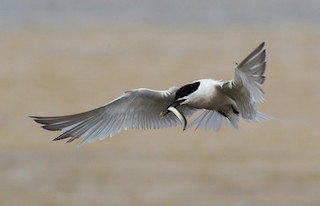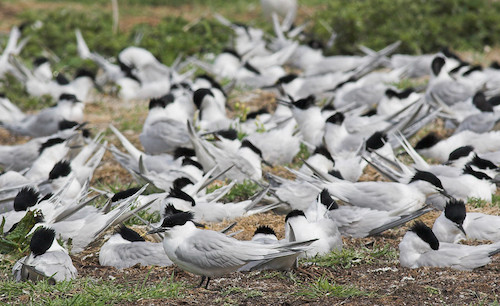 Lizard Point is a great place for spotting migrant birds, such as Sandwich Terns, as they head to their breeding grounds.
Lizard Point is a great place for spotting migrant birds, such as Sandwich Terns, as they head to their breeding grounds.
Photo: © Natural England/Allan Drewitt
Scientific name: Sterna sandvicensis
Conservation status: IUCN Red List, Least Concern; Europe, Least Concern; UK Birds of Conservation Concern, Amber
What to look for:
· Colouring and appearance: In full breeding plumage, white with grey on back and on long pointed wings, dark primaries on wings, black cap with crest, forked tail, yellow-tipped black beak and black legs. Out of the breeding season, the forehead turns white, but the crest remains black.
· Size: Wingspan 100 cm, length 38 cm.
· Where: UK breeding colonies include the North Norfolk Coast, Minsmere in Suffolk, and Dungeness on the Kent coast. Elsewhere on migration.
· Call: Listen here
· Similar species: Arctic Tern, Common Tern, Roseate Tern, Little Tern. Only the Sandwich Tern has the yellow-tipped black bill.
 There are a few breeding colonies of Sandwich Terns in the UK, mostly on protected coastal nature reserves. In Cornwall, we can spot them on migration in spring and autumn, en route to and from their overwintering grounds further south in Europe and Africa.
There are a few breeding colonies of Sandwich Terns in the UK, mostly on protected coastal nature reserves. In Cornwall, we can spot them on migration in spring and autumn, en route to and from their overwintering grounds further south in Europe and Africa.
The Sandwich Tern generally breeds alongside other tern species, such as the Arctic and Common Tern, as well as other seabirds. The breeding season in Europe, including the UK, is from May to June, with birds arriving from late March. Each pair makes a shallow scrape in the shingle to serve as a nest, lining it with shell fragments, vegetation and even excrement. Clutches are small – just one or two eggs – incubated for the first few days by the female and then by both adults. After hatching, different adult pairs might share protection duties by gathering several chicks together into a ‘crèche’.
As well as breeding colonially, the Sandwich Tern also forms large feeding groups wherever its prey of small fish and crustaceans is in abundance. Individuals dive into the water from above the surface, and can sometimes be spotted hovering over shallower water as they search for food.
The Amber status in the UK is due to recent declines in breeding populations.

Did you know…?
…The Sandwich Tern does not get its name because it likes sandwiches! It is named for Sandwich in Kent, from where the bird was originally described by ornithologist John Latham in 1787. The specific name sandvicensis usually refers to a species hailing from Hawaii (previously known as the Sandwich Islands), but not in this case. The Sandwich Tern does not occur on Hawaii.
More information and references:
Svensson, L., Mullarney, K., Zetterstrom, D.,1986. Collins Bird Guide, second edition (translated by Christie, D., Svensson, L.). HarperCollins, London.
Published: April 2016
Author: Amanda Scott
Photos: © Natural England/Allan Drewitt
